Fortaleza
Fortaleza ([foʁtaˈlezɐ], locally [fɔɦtaˈlezɐ], Portuguese for Fortress) is the state capital of Ceará, located in Northeastern Brazil. It belongs to the Metropolitan mesoregion of Fortaleza and microregion of Fortaleza. It is Brazil's 5th largest city and the twelfth richest city in the country in GDP. It also has the third richest metropolitan area in the North and Northeast regions. It is an important industrial and commercial center of Brazil, the nation's eighth largest municipality in purchasing power. According to the Ministry of Tourism, the city reached the mark of second most desired destination of Brazil and fourth among Brazilian cities in tourists received. The BR-116, the most important highway of the country, starts in Fortaleza. The municipality is part of the Common Market of Mercosur Cities, and also the Brazilian state capital which is closest to Europe, 5608 km (3484 miles) from Lisbon, Portugal.[1][2]
Fortaleza | |
|---|---|
| Municipality of Fortaleza Município de Fortaleza | |
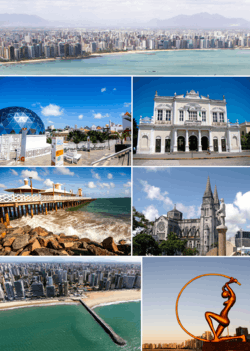 Clockwise from top: Panorama view of downtown Aratanha and Maranguape area, Theatro José de Alencar, Fortaleza Metropolitan Cathedral, A monument of the Guardian of Iracema in Iracema Beach, Meireles Beach, Ingleses Bridge in Iracema Beach, Dragão do Mar Center of Art and Culture | |
 Flag  Seal | |
| Nicknames: Fortal Miami Brasileira (Brazilian Miami) Terra da Luz (Land of Light) | |
| Motto(s): "Fortitudine" (Latin) | |
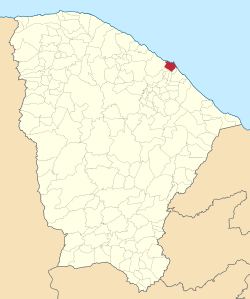 | |
 Fortaleza Location in Brazil  Fortaleza Fortaleza (South America) | |
| Coordinates: 03°43′39″S 38°31′39″W | |
| Country | |
| Region | Northeast |
| State | |
| Founded | April 13, 1726 |
| Government | |
| • Type | Mayor-council |
| • Mayor | Roberto Cláudio (PDT) |
| • Deputy mayor | Moroni Torgan (DEM) |
| Area | |
| • City & Municipality | 314.93 km2 (121.60 sq mi) |
| • Metro | 7,440.053 km2 (2,872.621 sq mi) |
| Elevation | 21 m (69 ft) |
| Population (2018) | |
| • City & Municipality | 2,643,247 |
| • Rank | 5th |
| • Metro | 4,074,730 |
| • Metro density | 547,67/km2 (141,850/sq mi) |
| Demonym(s) | Portuguese: Fortalezense |
| Time zone | UTC−3 (BST) |
| Postal Code | 60000-001 to 61599-999 |
| Area code(s) | +55 85 |
| Website | www |
To the north of the city lies the Atlantic Ocean; to the south are the municipalities of Pacatuba, Eusébio, Maracanaú and Itaitinga; to the east is the municipality of Aquiraz and the Atlantic Ocean; and to the west is the municipality of Caucaia. Residents of the city are known as Fortalezenses. Fortaleza is one of the three leading cities in the Northeast region together with Recife and Salvador.[2][3]
History
Colonial period
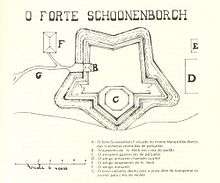
Fortaleza's history began on February 2, 1500, when Spaniard Vicente Pinzón landed in Mucuripe's cove and named the new land Santa Maria de la Consolación. Because of the Treaty of Tordesillas, the discovery was never officially sanctioned. Colonisation began in 1603, when the Portuguese Pero Coelho de Souza constructed the Fort of São Tiago and founded the settlement of Nova Lisboa (New Lisbon). After a victory over the French in 1612, Martins Soares Moreno expanded the Fort of São Tiago and changed its name to Forte de São Sebastião.[4]
In 1630 the Dutch invaded the Brazilian Northeast and in 1637 they took the Fort of São Sebastião and ruled over Ceará. In battles with the Portuguese and natives in 1644 the fort was destroyed.[4] Under captain Matthias Beck the Dutch West Indies Company built a new fortress by the banks of river Pajeú. Fort Schoonenborch ("graceful stronghold") officially opened on August 19, 1649. After the capitulation of Pernambuco in 1654, the Dutch handed over this fortress to the Portuguese, who renamed it Fortaleza da Nossa Senhora de Assunção ("Fort of Our Lady of the Assumption"), after which the city of Fortaleza takes its name.[5]
Fortaleza was officially founded as a village 1726, becoming the capital of Ceará state in 1799.[6]
Imperial period
During the 19th century, Fortaleza was consolidated as an urban centre in Ceará, supported by the cotton industry. With the transformation of the city into a regional export center and with the increase of direct navigation to Europe, the customs building of Fortaleza was built in 1812. In 1824, the city was targeted by the revolutionaries of Confederation of the Equator.
Republican period
The city gained a number of new districts in the 1930s, including Messejana and Porangaba.[7] In 1954, the first university in the city was created, the Universidade Federal do Ceará (UFC).[8]
In 1983 DIF I started to integrate the territory of the new city of Maracanaú, which, just some years ago, was made again part of the Greater Fortaleza (the city's Metropolitan area). In the 1980s, Fortaleza exceeded Recife in population terms, becoming the second most populous city in Northeastern Brazil, with 2,571,896 inhabitants.[9]
Geography
Climate

Fortaleza has a typical tropical climate, specifically a tropical wet and dry climate (Köppen climate classification: As), with high temperatures and relative humidity throughout the year. However, these conditions are usually relieved by pleasant winds blowing from the ocean. Average temperatures are not much different throughout the year. December is the warmest month, with a high of 30.7 °C (87.3 °F)[10] and low of 24.6 °C (76.3 °F).[11] The rainy season spans from January to June, with rainfall particularly prodigious in March and April.[12] The average annual temperature is 26.6 °C (79.9 °F).[13] The relative humidity in Fortaleza is 79%,[14] with average annual rainfall of 1,608.4 millimetres (63.32 in).[12] There is usually rain during the first seven months of the year from January to July. During this period, relative humidity is high. Fortaleza's climate is usually very dry from August to December, with very little rainfall.[12][14]
Rainfall is like all of Northeastern Brazil among the most variable in the world, comparable (for similar average annual rainfalls) to central Queensland cities like Townsville and Mackay.[15] In the notorious drought year of 1877 as little as 468 millimetres or 18.43 inches fell, and in 1958 only 518 millimetres or 20.39 inches, but in the Nordeste's record wet year of 1985 Fortaleza received 2,841 millimetres or 111.85 inches.
| Climate data for Fortaleza (1961–1990) | |||||||||||||
|---|---|---|---|---|---|---|---|---|---|---|---|---|---|
| Month | Jan | Feb | Mar | Apr | May | Jun | Jul | Aug | Sep | Oct | Nov | Dec | Year |
| Record high °C (°F) | 37.7 (99.9) |
33.3 (91.9) |
32.8 (91.0) |
32.6 (90.7) |
32.8 (91.0) |
31.8 (89.2) |
33 (91) |
34.4 (93.9) |
32.7 (90.9) |
33.4 (92.1) |
33 (91) |
33.2 (91.8) |
37.7 (99.9) |
| Average high °C (°F) | 30.5 (86.9) |
30.1 (86.2) |
29.7 (85.5) |
29.7 (85.5) |
29.9 (85.8) |
29.6 (85.3) |
29.5 (85.1) |
29.9 (85.8) |
30.2 (86.4) |
30.5 (86.9) |
30.7 (87.3) |
30.7 (87.3) |
30.1 (86.2) |
| Daily mean °C (°F) | 27.1 (80.8) |
26.9 (80.4) |
26.4 (79.5) |
26.2 (79.2) |
26.2 (79.2) |
25.8 (78.4) |
25.6 (78.1) |
26 (79) |
26.4 (79.5) |
26.9 (80.4) |
27.2 (81.0) |
27.3 (81.1) |
26.6 (79.9) |
| Average low °C (°F) | 24.4 (75.9) |
24 (75) |
23.6 (74.5) |
23.4 (74.1) |
23.3 (73.9) |
22.8 (73.0) |
22.4 (72.3) |
22.7 (72.9) |
23.4 (74.1) |
24.1 (75.4) |
24.4 (75.9) |
24.6 (76.3) |
23.6 (74.5) |
| Record low °C (°F) | 20 (68) |
21.2 (70.2) |
20.2 (68.4) |
20 (68) |
20.6 (69.1) |
20.3 (68.5) |
19.4 (66.9) |
19.4 (66.9) |
20.5 (68.9) |
21 (70) |
21.3 (70.3) |
21 (70) |
19.4 (66.9) |
| Average rainfall mm (inches) | 119.1 (4.69) |
204.6 (8.06) |
323.1 (12.72) |
356.1 (14.02) |
255.6 (10.06) |
141.8 (5.58) |
94.7 (3.73) |
21.8 (0.86) |
22.7 (0.89) |
13 (0.5) |
11.8 (0.46) |
44.1 (1.74) |
1,608.4 (63.31) |
| Average rainy days (≥ ≥ 1 mm) | 11 | 15 | 22 | 21 | 19 | 14 | 10 | 5 | 5 | 4 | 3 | 6 | 132 |
| Average relative humidity (%) | 78.1 | 81.4 | 84.7 | 85.2 | 83.6 | 81 | 78.8 | 75.3 | 74.4 | 74 | 73.7 | 75.9 | 78.8 |
| Mean monthly sunshine hours | 225.2 | 182.3 | 150 | 157.1 | 208.4 | 238.7 | 268.3 | 295.9 | 281.6 | 291.4 | 282.2 | 262.3 | 2,843.4 |
| Source: Brazilian National Institute of Meteorology (INMET).[10][11][12][13][14][16][17][18][19] | |||||||||||||
Vegetation
In Fortaleza there are some remaining areas of mangrove in preserved areas.[20][21] Ten miles offshore is the Pedra da Risca do Meio Marine State Park, created in 1997 to protect the reefs.[22]
Ecology and environment

The vegetation of Fortaleza is typically coastal. The restinga areas are found in dune regions near the mouths of the Ceará, Cocó and Pacoti rivers, in the beds of which there is still a mangrove forest. In other green areas of the city, there is no longer native vegetation, consisting of varied vegetation, fruit trees more commonly.[23] The city is home to seven environmental conservation units. These are the Sabiaguaba Dunes Municipal Natural Park, the Sabiaguaba Environmental Protection Area, the Maraponga Lagoon Ecological Park, the Cocó Ecological Park, the Ceará River Estuary Environmental Protection Area, the Environmental Protection Area of the Rio Pacoti and the Pedra da Risca do Meio Marine State Park.[24] There is also, in the city, the Area of Relevant Ecological Interest of Sírio Curió, that protects the last enclave of Atlantic Forest in the urban zone.[25]
The Cocó River is part of the river basin of the east coast of Ceará and has a total length of about 50 km in its main area. The park is inserted in the area of greater environmental sensitivity of the city, where it is possible to identify geoenvironmental formations such as coastal plain, fluvial plain and surface of the coastal trays. The Cocó river mangrove is home to mollusks, crustaceans, fish, reptiles, birds and mammals. The park has a structure of visitation, with guides, ecological trails and equipment and events of environmental education and ecotourism. The Coaçu River, affluent of the river Cocó, forms in its bed the lagoon of the Precabura.[26][27]
The Rio Pacoti provides much of the water supply for Fortaleza.[28] At the municipal boundary with Caucaia, the estuary of the Rio Ceará is covered by an environmental protection area (APA), which was set up in 1999.[29]
Demographics
According to the 2010 IBGE Census, there were 2,315,116[30] people residing in the city of Fortaleza. The census revealed the following numbers: 1,403,292 Pardo (multiracial) people (57.2%), 901,816 White people (36.8%), 110,811 Black people (4.5%), 33,161 Asian people (1.4%), 3,071 Amerindian people (0.1%).[30]
In 2010, the city of Fortaleza was the 5th most populous city proper in Brazil, after São Paulo, Rio de Janeiro, Salvador, and Brasília.[31]
In 2010, the city had 433,942 opposite-sex couples and 1,559 same-sex couples. The population of Fortaleza was 53.2% female and 46.8% male.[30]
The following cities are included in the metropolitan area of Fortaleza (ordered by population): Fortaleza, Caucaia, Maracanaú, Maranguape, Aquiraz, Pacatuba, Pacajus, Horizonte, São Gonçalo do Amarante, Itatinga, Guaiúba and Chorozinho.[32]
According to a genetic study from 2011, 'pardos' and whites' from Fortaleza, which comprise the largest share of the population, showed European ancestry of about 70%, the rest divided between Native American and African ancestries.[33] A 2015 study, however, found out the following composition in Fortaleza: 48,9% of European contribution, 35,4% of Native American input and 15,7% of African ancestry.[34]
.png)
Religion
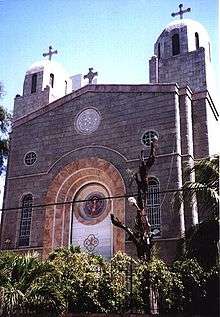
.jpg)
The prevailing religion of Fortaleza is the Roman Catholic branch of Christianity.
| Religious affiliation | Percentage | Number |
|---|---|---|
| Catholic | 79.0% | 1,691,487 |
| Protestant | 12.58% | 269,469 |
| No religion | 5.99% | 128,190 |
| Kardecist | 0.83% | 17,780 |
| Jehovah's Witnesses | 0.64% | 13,758 |
| Other religions | 0.7% | 15,923 |
According to the census of 2010[30], 1,664,521 people, 67.88% of the population, followed Roman Catholicism, 523,456 (21.35%) were Protestant, 31 691 (1.29%) represented Spiritism and 162 985 (6.65%) had no religion whatsoever. Other religions, such as Umbanda, Candomblé, other Afro-Brazilian religions, Spiritualism, Judaism, Hinduism, Buddhism, Islam, other Eastern religions, Esotericism and other Christian churches like Mormon had a smaller number of adherents.[36]
Politics
The administration of the municipality is made from the executive and legislative branches.[37] Roberto Cláudio, of the PDT, won 650,607 votes in the 2012 election, and was elected mayor.[38][39] Legislative power rests with the City Council of Fortaleza, composed of 43 city councilors, elected for four-year terms, responsible for drafting municipal laws and supervising the executive.[40] The municipality is, in addition, governed by organic law. In January 2015, there were 1 659 091 voters in Fortaleza (26,457% of the total state),[41] distributed in thirteen electoral zones. The number of persons directly and indirectly employed in the municipal public administration in 2013 was respectively 31 318 and 4 950.[42]
The city also houses the seat of state executive power, the Abolition Palace, occupied by governor Camilo Santana, of the PT, elected in the general elections in Brazil in 2014.[43] historically headquarters of the Iracema Club, which was Ceded to the Municipal Hall and now houses municipal executive bodies.[44] In the city, there is the Administrative Center Governor Virgílio Távora.[45]
Among the institutions present in the city, are the Fortaleza Air Base, the Port Authority of Ceará, School of Apprentice Sailors of Ceará and the Command of the Tenth Military Region. The city also has units of the International Committee of the Red Cross and UNICEF.[46] Since 1996, a city is part of the Common Market of Cities of Mercosur.[47]
Economy
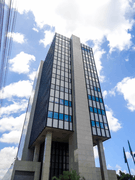

At the beginning of the decade of 2000, among the capitals of the Northeast, Fortaleza had the third largest Gross Domestic Product (GDP), being surpassed by Recife and Salvador.[48] In 2012, the GDP of Fortaleza reached the value of 43.4 billion Reais, the tenth highest of the country.[49] In the same year, the value of taxes on products net of subsidies at current prices was R $6,612,822,000 and the municipality's GDP per capita was R$17.359,53.[50] The city's booming economy is reflected in purchasing power, the country's eighth largest, with estimated consumption potential at 42 billion reais in 2014.[51]
The main economic source of the municipality is centered in the tertiary sector, with its diversified segments of commerce and service rendering. Next, the secondary sector stands out, with the industrial complexes.[50] In 2012, the city had 873,746 people in employment.[52]
Culture

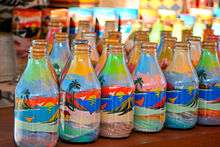
According to the Master Plan of Fortaleza, the Special Areas for the Preservation of Historic, Cultural and Archaeological Heritage are the regions of the Center, Parangaba, Alagadiço Novo/José de Alencar, Benfica, Porangabuçu and Praia de Iracema. Properties of conservation interest.[53] The architectural heritage of Fortaleza in the form of fallen goods, however, is predominantly concentrated in the center of the city.[54][55] The Mucuripe Lighthouse is unfortunately in ruins today, Ceará and Fortaleza were part of the pioneering group of states and cities to adopt public policies to protect the living intangible heritage of their culture, through the Masters of Culture program.[56]
Museums, theatres and cultural spaces
Among the theaters, the largest and most popular are Theatro José de Alencar, São José Theater, São Luiz Cinema Theater, and Teatro RioMarand Teatro Via Sul.[57] The Ceará Museum houses numerous artifacts, including pieces of paleontology and furniture.[58] The Dragão do Mar Center of Art and Culture is the main cultural centre, and includes the Ceará Museum of Culture, the Museum of Contemporary Art of Ceará, theaters, a planetarium, cinemas, shops and spaces for public presentations, as well as housing the Public Library Governador Menezes Pimentel, Oporto Iracema of the Arts and the School of Arts and Crafts Thomaz Pompeu Sobrinho.[59] The Casa de Jose Alencar is one of the Brazilian museums recognised as dealing with Brazilian literature.[60] It was opened in 1964 and houses art collections, a gallery, a library and the ruins of the first steam power plant in Ceará.[61] In the different SERs of the city, the complexes of the CUCA Network are spread, which are facilities dedicated to art, leisure and education, especially for young people.[62]
Freemasonry is represented by the Grand Masonic Lodge of Ceará and the Great State East of Ceará. There are also service clubs in the city, such as the Lions Club and Rotary International.[63]
The Ceará handicraft has its main market and showcase in Fortaleza. In the city, there are several specific places for trade in handicraft products, such as the Ceará Craft Center (CeArt), Ceará Tourism Center (Emcetur), Crafts Fair of Beira-Mar, and on Avenida Monsenhor Tabosa.[64]
Literature and cinema
.png)

The main literary manifestation of Fortaleza's history emerged at the end of the 19th century, in the cafes of Praça do Ferreira, known as the Spiritual Bakery, a pioneer in the dissemination of modern ideas in Brazilian literature that would only be adopted nationally in the following century, in the Modern Art Week.[65][66] The most important historical entities of high culture still present in the city are the Ceará Institute and the Ceará Academy of Letters, the first academy of letters created in Brazil, founded in 1887 and 1894 respectively. The Ceará Institute has helped launch important names in national historiography and philosophy, such as Farias Brito and Capistrano de Abreu.[67] Among the writers who are members of the Cearense Academy of Letters and members or patrons of the Brazilian Academy of Letters, are Gustavo Barroso, Araripe Júnior, José de Alencar, Heráclito Graça, Franklin Tavora, Clóvis Beviláqua and Rachel de Queiroz, the first woman to Be part of the entity. The Casa de Juvenal Galeno is another historical cultural institution of Fortaleza, named after one of the greatest poets born in the city, Juvenal Galeno. The house became well known for its festivals of poetry and seminaries.[68]
In cinema, the most well known name is Zelito Viana, director of films like Villa-Lobos: A Life of Passion and Life and Death of Severina. More recently, Karim Aïnouz has directedMadame Satã, Suely in the Sky and Futuro Beach, and script of Lower City, Cinema, Aspirins and Vultures and Behind the Sun. Another current exponent of cinema born in Fortaleza is Halder Gomes, director and screenwriter of Holliúdy Cinema. New filmmakers in the city have gained in recent years prominent exhibitions such as at the Rio de Janeiro International Film Festival.[69] The most traditional cinema event in Fortaleza is the Cine Ceará (Ibero-American Film Festival), considered one of the main festivals of the country.[70]
Fashion
The main fashion name in the city is the Lino Villaventura, who, from Fortaleza, designed himself nationally and internationally and today is one of the main names of São Paulo Fashion Week, besides being one of the founding designers of this fashion week.[71] There are major events in the city, such as the Dragão Fashion Brasil, considered the largest fashion event in the Northeast and the third largest in the country.[72]
Much of the clothing that is produced in Ceará flows through Fortaleza, which in turn is recognized as one of the most important textile centers of the country, giving the garment industry great weight in the metropolitan economy.[73] Brands of the city like Santana Textiles and headquarters of brands like Esplanada and Otoch have considerable regional influence.[74]
Music
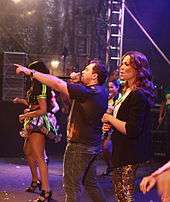

Forró is the most popular musical genre in the city. Bands originating in Fortaleza, such as Mastruz com Leite and Aviões do Forró, were responsible for the popularization of electronic forró, which promoted the revaluation of the accordion in the genre and brought it closer to pop music. The forró pé-de serra, however, still holds great cultural influence and commercial prominence in the city.[75]
In Música popular brasileira, some of the names from Fortaleza were Fagner, Ednardo, Belchior (from Sobral but lived in Fortaleza) and Amelinha.[75] The musical tradition of Fortaleza, however, goes back to the composer Alberto Nepomuceno, one of the greatest names in classical music in Brazil, a pioneer in the development of the country's musical nationalism, and therefore considered the "founder of Brazilian music". The Alberto Nepomuceno Conservatory is one of the city's leading music schools.[75]
Carnaval
Fortaleza hosts one of the noted Brazilian Carnivals. Its main locations are Iracema Beach and Avenue Domingos Olimpio.[76]
Cuisine

The gastronomy of Fortaleza is very close to the typical Northeastern cuisine, and, traditional include the baião de dois, usually accompanied by barbecue of mutton or meat of sun, and "tapioca" which is a pancake made from the starch of cassava. The seafood is another ingredient of typical dishes of fortalezeense cuisine, such as the steak moqueca and the mackerel and snapper fish.[77]
The fruit of the sea identity of the coast of the state is the crab. Shrimp and lobster are also widely used delicacies in dishes such as shrimp rice or shrimp dumplings.[78]
Tourism
Acquario Ceará, due to be one of the largest oceanariums in Brazil, is currently under construction.[79] Attractions such as the Beach Park theme park, located in the Great Fortaleza, Avenida Beira Mar and its bars, restaurants and music clubs, the beaches of Futuro and Iracema and Pirata Bar have placed Fortaleza among the Brazilian destinations preferred by Europeans.[80]
Scuba diving is possible in the area of Pedra da Risca do Meio Marine State Park, a marine protected area located about 10 nautical miles from the shoreline of Fortaleza.[81]
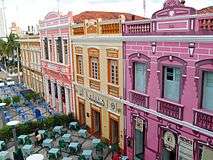 Historic Centre of Fortaleza
Historic Centre of Fortaleza.jpg) Aerial view of the city
Aerial view of the city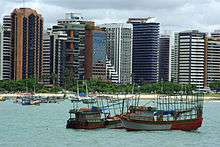 Boats and skyscrapers in the litoral.
Boats and skyscrapers in the litoral.
Urban beaches
Fortaleza has about 25 kilometres (16 mi) of urban beaches. Mucuripe is the place where jangadas can be found. Still used by fishermen to go into high seas, jangadas can be seen along the way during the afternoon and evenings, and returning from the sea in the morning; part of the catch of the day is sold in an old-style fish market.[82]
.jpg) Iracema Beach
Iracema Beach Mucuripe Beach
Mucuripe Beach Meirelles Beach
Meirelles Beach
Education
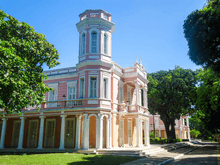
In 2010, the level of the education factor of the Strengthening Human Development Index was medium, despite its great advance, which went from 0.367 to 0.695 between 1991 and 2010. According to data from the 2010 Human Development Atlas of Brazil, Fortaleza's adult education levels were divided as follows: 8.57% did not complete primary school or were illiterate, 62.43% had completed elementary education, 45.93% had completed high school and 13.73% had completed higher education.[30]
Health
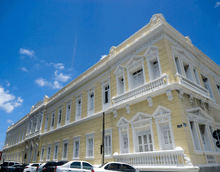
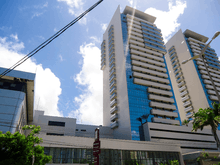
The health indexes of the Fortaleza population are better than the Brazilian average. According to data from 2010, the infant mortality rate up to one year old was 15.8 per 1000 live births in Fortaleza, against a Brazilian average of 16.7.[83] By 2013, 90.6% of children under one year of age had their immunization records up to date. In 2012, 37,577 live births were registered, and the infant mortality rate up to five years of age was 13.2 per 1000. Of the total number of children under two years old weighed by the Family Health Program in 2013, 0.8% were malnourished.[84]
In 2009, Fortaleza had a total of 35 general hospitals, of which 11 were public, 21 were private, two were philanthropic, and one was a trade union. The Doctor José Frota Institute is the largest hospital administered by the Municipal Government, and the General Hospital of Fortaleza is the largest hospital administered by the State Government. In addition, it had 54 specialized hospitals and eight polyclinics. The total number of physicians working in the health network of the municipality was 13,604, approximately 5.4 per thousand inhabitants.[85] Fortaleza has 117 units of health posts, three UPAs administered by the municipality and six administered by the state.[86][87] The first hospital built in Fortaleza was the Santa Casa de Misericórdia, founded in 1861.[88] Among the most important public health institutions in the city, the most important is the Dr. José Frota Institute, the largest hospital administered by the Municipal Government, and the General Hospital of Fortaleza, the largest hospital administered by the State Government. Among the private institutions, the largest are the Unimed Fortaleza Regional Hospital, Antônio Prudente Hospital, Monte Klinikum Hospital and São Mateus Hospital.[89]
One of the most important basic health programs in Fortaleza is the Family Health Program, within which the city is in third place in the country in extension of coverage, with hundreds of teams distributed in dozens of care units.[90] The Emergency Mobile Care Service (SAMU) is the municipality's health care service, which serves an average of 200 daily occurrences.[91]
The University Hospital Walter Cantídio is the largest liver transplantation facility in the country.[92] The Faculty of Medicine of the UFC is the 13th best medical school in Brazil, 2nd best medical school in the North and Northeast regions and the best medical school in Ceará. UFC's medical degree is still one of the most popular in the country.[93]
Transportation
International Airport
_1.jpg)
The current passenger terminal of Pinto Martins – Fortaleza International Airport, located in the center of Fortaleza, was built between 1996 and 1998.[94] The airport is now undergoing an expansion process, from which the number of boarding bridges will increase from seven to sixteen and the passenger terminal will be expanded from 38,000 m² to 133,000 m². In 2014, the airport was capable of serving 6.2 million passengers per year, but after expansion, capacity would be 11.2 million.[95]
Pinto Martins Airport is the third busiest airport in the Northeast Region and one of the busiest in the country, receiving on average 1,500 international aircraft and 65,000 domestic aircraft per year. In 2013, it received more than 5.9 million passengers.[96]
Roads
In 2013, Fortaleza had 908,074 vehicles, of which 511,109 were cars, and 229 154 motorcycles.[98] Traffic density at peak times in the city is rated as the fourth largest in the country, with 48% of congested roads.[98] The cycle network of Fortaleza is composed of 116.4 km, of which 78.8 km are cycle paths and 37.6 km are cycle paths. The municipality also has a public bicycle system, Bicicletar, which had 40 stations and 400 units in April 2015. In 2015, the municipal taxi fleet was composed of 4 886 vehicles, including common, adapted and special use vehicles.[98]
The city's road transport system is regulated by the Fortaleza Urban Transportation Company (ETUFOR), an agency of the Municipality of Fortaleza. The collective transport carried out by buses is called the Integrated Transportation System (SIT-FOR), and its operation began in 1992.[99]
The system of traffic monitoring is known by the acronym CTAFOR,[98] which stands for "Controle de Tráfego em Área de Fortaleza" (Traffic Control of the Area of Fortaleza).
Subway
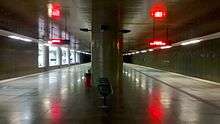
The Fortaleza Metro is operated by Companhia Cearense de Transportes Metropolitanos (Metrofor). Founded on May 2, 1997, the company is responsible for administration, construction and metro planning in Fortaleza and its metropolitan region. The system is headed by the Government of the State of Ceará and has as current president Eduardo Hotz.[100]
The Fortaleza Metro started on October 1, 2014. As of 2014 18 of the 20 stations planned for the South Line are in operation, along with 9 stations of the West Line.[101]
MetroFor is the 43 kilometres (27 mi) rapid transit system for the city of Fortaleza.[100]
Bus stations
Engenheiro João Tomé Bus station is the Fortaleza Bus terminal official name. Was Contstructed in 1973. It carries a daily average of over 8,000 passengers. 35 Bus companies and close to 200 bus lines. The bus station is centrally located within the city limits. Only 3 kilometres (1.9 mi) from the city centre and 5 kilometres (3.1 mi) from Praia de Iracema Beach. Fortaleza bus station is accessible by at least 2 city bus lines: Av. Borges de Melo I and Av. Borges de Melo II. Fortaleza has multiple Bus Rapid Transit, or BRT, lines throughout the city and has plans to extend this network of transportation (BRTBrasil.org)[102]
Bike lanes
Fortaleza officially has 116.4 kilometres (72.3 mi) of bike lanes.[103]
Public Transportation Statistics
The average person in Fortaleza spends 89 minutes riding public transit on a weekday, and 30% of public transit riders ride for more than 2 hours every day. People typically wait 24 minutes at a stop or station for public transit; on average, 52% of riders wait for over 20 minutes every day. The average distance people usually ride in a single trip with public transit is 6.8 km, while 10% travel for over 12 km in a single direction.[104]
Sports
The main games of the Ceará State Championship are played in Fortaleza. There are several association football clubs in the city, including Ceará SC, Fortaleza EC and Ferroviário AC. Fortaleza was one of the host cities of the 2013 FIFA Confederations Cup and 2014 FIFA World Cup.[105][106]
.jpg) Internal view of Arena Castelão
Internal view of Arena Castelão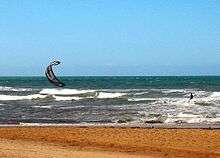 Kitesurfing at Futuro Beach
Kitesurfing at Futuro Beach
Notable people

.jpg)
- José de Alencar, famous writer from the 19th century
- Alberto Nepomuceno, famous composer from the 19th century
- Rachel de Queiroz, first female writer in Academia Brasileira de Letras
- André Diamant, international chess grandmaster
- Casimiro Montenegro Filho, founder of the Brazilian Air Force Aeronautical Technologic Institute - ITA
- Maurício Peixoto, mathematician, one of the founders of IMPA
- Gilberto Câmara, former director of Brazil's National Institute for Space Research (INPE)
- Hélder Câmara, Roman Catholic Archbishop nominated for the Nobel Peace Prize
- Castelo Branco, former president (1964–67)
- Karim Aïnouz, film director
- Ed Lincoln, musician and composer
- Shelda Bede, beach volleyball player and olympic medalist
- Raffael, professional footballer
- Ronny Araújo, professional footballer
- Mário Jardel, retired professional footballer
- Marcus Aurélio, mixed martial arts professional
- Wilson Gouveia, mixed martial arts professional
- Thiago Alves, mixed martial arts professional
- Hermes França, mixed martial arts professional
- Jorge Gurgel, mixed martial arts professional
- Heloneida Studart, writer, politician, women's rights advocate
Twin towns – sister cities
Fortaleza is twinned with:[107]







See also
References
- "Fortaleza é a quinta capital mais populosa e lidera a sétima maior região metropolitana - Ceará - O POVO Online". Archived from the original on December 6, 2016. Retrieved December 10, 2016.
- Garmany, Jeff (2011). "Situating Fortaleza: Urban space and uneven development in northeastern Brazil". Cities. Elsevier. 28 (1): 45–52. doi:10.1016/j.cities.2010.08.004.
- Istrate, Emilia; Nadeau, Carey Anne (November 30, 2012). "Global Metro Monitor: Slowdown, Recovery, and Interdependence 2012" (PDF). Brookings Institution. Retrieved October 31, 2019.
- History of Fortaleza and Ceará Archived July 14, 2014, at the Wayback Machine at Fortaleza, Ceará site
- The Fortress of Nossa Senhora da Assunção Archived June 9, 2014, at the Wayback Machine at Fortaleza, Ceará site
- "Fortaleza". 2014 FIFA World Cup Brazil. FIFA. Archived from the original on May 15, 2014. Retrieved May 14, 2014.
- "Fortaleza: Historia" (in Portuguese). IBGE. Retrieved June 27, 2020.
- "Universidade Federal do Ceará (UFC)". December 13, 2012. Archived from the original on December 21, 2016. Retrieved December 10, 2016.
- "Define fortaleza - Dictionary and Thesaurus". Archived from the original on April 22, 2016. Retrieved December 10, 2016.
- "Temperatura Máxima (°C)" (in Portuguese). Brazilian National Institute of Meteorology. 1961–1990. Archived from the original on August 8, 2014. Retrieved August 19, 2014.
- "Temperatura Mínima (°C)" (in Portuguese). Brazilian National Institute of Meteorology. 1961–1990. Archived from the original on August 8, 2014. Retrieved August 19, 2014.
- "Precipitação Acumulada Mensal e Anual (mm)" (in Portuguese). Brazilian National Institute of Meteorology. 1961–1990. Archived from the original on August 8, 2014. Retrieved August 19, 2014.
- "Temperatura Média Compensada (°C)" (in Portuguese). Brazilian National Institute of Meteorology. 1961–1990. Archived from the original on August 8, 2014. Retrieved August 19, 2014.
- "Umidade Relativa do Ar Média Compensada (%)". Brazilian National Institute of Meteorology. Archived from the original on August 8, 2014. Retrieved August 19, 2014.
- Dewar, Robert E. and Wallis, James R; ‘Geographical patterning of interannual rainfall variability in the tropics and near tropics: An L-moments approach’; in Journal of Climate, 12; pp. 3457-3466
- "Número de Dias com Precipitação Mayor ou Igual a 1 mm (dias)". Brazilian National Institute of Meteorology. Archived from the original on August 27, 2014. Retrieved August 19, 2014.
- "Insolação Total (horas)". Brazilian National Institute of Meteorology. Archived from the original on August 8, 2014. Retrieved August 19, 2014.
- "Temperatura Máxima Absoluta (ºC)". Brazilian National Institute of Meteorology (Inmet). Retrieved August 19, 2014.
- "Temperatura Mínima Absoluta (ºC)". Brazilian National Institute of Meteorology (Inmet). Retrieved August 19, 2014.
- Manguezal do Rio Ceará Archived September 11, 2013, at the Wayback Machine (in Portuguese)
- Manguezal do Rio Cocó Archived November 13, 2013, at the Wayback Machine (in Portuguese)
- Parque Estadual Marinho da Pedra da Risca do Meio, SEMACE, Governo do Estado do Ceará, archived from the original on November 29, 2016, retrieved June 1, 2019
- "Plano de gestão integrada da orla do município de Fortaleza" (PDF) (in Portuguese). Ministério do Meio Ambiente do Brasil. August 2006. Archived (PDF) from the original on March 27, 2014. Retrieved February 22, 2015.
- "Meio Ambiente". Anuário de Fortaleza 2012-2013. Archived from the original on October 15, 2012. Retrieved March 10, 2015.
- "ARIE do Sítio Curió". SEMACE. Archived from the original on April 2, 2015. Retrieved March 10, 2015.
- "Unidades de conservação". Anuário de Fortaleza 2012-2013. Archived from the original on October 15, 2012. Retrieved March 10, 2015.
- "Lagoas de Fortaleza". Anuário de Fortaleza 2012-2013. Archived from the original on October 15, 2012. Retrieved March 10, 2015.
- "Corredor Ecológico do Rio Pacoti" (in Portuguese). SEMACE. Archived from the original on May 6, 2017. Retrieved May 2, 2017.
- "Área de Proteção Ambiental do Estuário do Rio Ceará" (in Portuguese). SEMACE. Archived from the original on May 6, 2017. Retrieved May 3, 2017.
- 2010 IGBE Census Archived May 14, 2012, at the Wayback Machine (in Portuguese)
- The largest Brazilian cities – 2010 IBGE Census Archived January 6, 2012, at the Wayback Machine (in Portuguese)
- "Fortaleza Ceara Brazil - travel information". Archived from the original on April 1, 2017. Retrieved December 10, 2016.
- Pena, Sérgio D. J.; Pietro, Giuliano Di; Fuchshuber-Moraes, Mateus; Genro, Julia Pasqualini; Hutz, Mara H.; Kehdy, Fernanda de Souza Gomes; Kohlrausch, Fabiana; Magno, Luiz Alexandre Viana; Montenegro, Raquel Carvalho; Moraes, Manoel Odorico; Moraes, Maria Elisabete Amaral de; Moraes, Milene Raiol de; Ojopi, Élida B.; Perini, Jamila A.; Racciopi, Clarice; Ribeiro-dos-Santos, Ândrea Kely Campos; Rios-Santos, Fabrício; Romano-Silva, Marco A.; Sortica, Vinicius A.; Suarez-Kurtz, Guilherme (February 16, 2011). "The Genomic Ancestry of Individuals from Different Geographical Regions of Brazil Is More Uniform Than Expected". PLOS ONE. 6 (2): e17063. doi:10.1371/journal.pone.0017063. PMC 3040205. PMID 21359226.
- Magalhães da Silva, Thiago; Sandhya Rani, M. R.; de Oliveira Costa, Gustavo Nunes; Figueiredo, Maria A.; Melo, Paulo S.; Nascimento, João F.; Molyneaux, Neil D.; Barreto, Maurício L.; Reis, Mitermayer G.; Teixeira, M. Glória; Blanton, Ronald E. (July 1, 2015). "The correlation between ancestry and color in two cities of Northeast Brazil with contrasting ethnic compositions". Eur J Hum Genet. 23 (7): 984–989. doi:10.1038/ejhg.2014.215. PMC 4463503. PMID 25293718.
- "Sistema IBGE de Recuperação Automática – SIDRA". Sidra.ibge.gov.br. Archived from the original on June 14, 2011. Retrieved April 17, 2010.
- "População residente por cor ou raça e religião - Fortaleza". IBGE. Archived from the original on March 23, 2015. Retrieved February 16, 2015.
- "Constituição do Brasil". Palácio do Planalto. Archived from the original on May 5, 2016. Retrieved May 9, 2017.
- "Eleições 2012: Apuração: Fortaleza". G1. Archived from the original on April 30, 2017. Retrieved May 9, 2017.
- "Fortaleza: Apuração do segundo turno". Uol. Archived from the original on October 25, 2017. Retrieved May 9, 2017.
- "Fortaleza já conhece os 43 vereadores que ocuparão a Câmara Municipal". Diário do Nordeste. September 7, 2012. Archived from the original on October 25, 2017. Retrieved May 9, 2017.
- "Lei Orgânica de Fortaleza". CMFOR. 2012. Archived from the original on July 30, 2017. Retrieved May 9, 2017.
- "Perfil dos municípios brasileiros - Fortaleza". IBGE. 2013. Archived from the original on October 25, 2017. Retrieved May 9, 2017.
- "No Ceará, Camilo Santana sucede padrinho político e ministro Cid". G1. January 1, 2015. Archived from the original on October 25, 2017. Retrieved May 9, 2017.
- "Palácio Iracema". Governo do Estado do Ceará. April 25, 2011. Archived from the original on August 2, 2017. Retrieved May 9, 2017.
- "Governo do Estado do Ceará, Secretários e Órgãos vinculados". Governo do Estado do Ceará. Archived from the original on April 5, 2010. Retrieved May 9, 2017.
- "Faça a diferença". Catraca Livre. July 22, 2014. Archived from the original on February 15, 2015. Retrieved May 9, 2017.
- "Fortaleza". Mercociudades. Archived from the original on May 7, 2017. Retrieved May 9, 2017.
- "Produto Interno Bruto dos Municípios 1999-2002". IBGE. Archived from the original on August 6, 2017. Retrieved May 9, 2017.
- "Posição ocupada pelos 100 maiores municípios, em relação ao Produto Interno Bruto" (PDF). IBGE. 2012. Retrieved May 9, 2017.
- "Fortaleza". IBGE. Archived from the original on October 25, 2017. Retrieved May 9, 2017.
"Produto interno bruto dos municípios - 2012". IBGE. 2012. Archived from the original on September 14, 2017. Retrieved March 12, 2019. - "IPC Maps 2014" (PDF). IPC Marketing. Archived from the original (PDF) on May 8, 2014. Retrieved May 9, 2017.
- "Estatísticas do cadastro central de empresas - 2012" (in Portuguese). IBGE. 2012. Archived from the original on January 23, 2017. Retrieved August 8, 2019.
- "Zonas de preservação do patrimônio". O Povo. November 24, 2012. Archived from the original on February 8, 2015. Retrieved January 25, 2015.
- "Patrimônio Histórico e Cultural". Prefeitura Municipal de Fortaleza. Archived from the original on February 8, 2015. Retrieved January 25, 2015.
- "Histórico dos Bens Tombados". Prefeitura Municipal de Fortaleza. Archived from the original on February 8, 2015. Retrieved January 25, 2015.
- "Políticas públicas contemplam mestres da cultura". Portal Brasil. June 4, 2014. Archived from the original on August 8, 2017. Retrieved March 1, 2015.
- "Palco para todas as artes". Diário do Nordeste. March 9, 2014. Archived from the original on August 8, 2017. Retrieved January 24, 2015.
- "Fortaleza. Cronologia da Cidade". Revista Fale!. Archived from the original on August 8, 2017. Retrieved January 24, 2015.
- "Centro Dragão do Mar de Arte e Cultura". Governo do Estado do Ceará. July 31, 2014. Archived from the original on July 9, 2017. Retrieved January 24, 2015.
- "Os museus e a memória da literatura brasileira" (PDF). Instituto Brasileiro de Museus. 2011. Archived (PDF) from the original on August 8, 2017. Retrieved January 25, 2015.
- "Casa de José de Alencar" (PDF). Instituto do Patrimônio Histórico e Artístico Nacional. Archived from the original (PDF) on August 8, 2017. Retrieved January 25, 2015.
- "Rede Cuca comemora aniversário com programação especial". O Povo. February 20, 2015. Archived from the original on February 25, 2015. Retrieved March 8, 2015.
- "Clubes inovam para atrair público". Diário do Nordeste. June 9, 2012. Archived from the original on February 19, 2015. Retrieved January 25, 2015.
- "Artesanato" (in Portuguese). Governo do Estado do Ceará. Archived from the original on August 8, 2017. Retrieved January 25, 2015.
- Gilmar de Carvalho. "Letras sob o sol e o areal". Folha de S. Paulo. Archived from the original on December 15, 2018. Retrieved January 25, 2015.
- Luciana Brito (2012). "Presença da Padaria Espiritual na História da Imprensa e das Artes no Ceará". Unesp. Archived from the original on April 25, 2018. Retrieved January 25, 2015.
- "Academia Cearense de Letras: nova aos 120 anos". O Estado. August 29, 2014. Archived from the original on December 15, 2018. Retrieved February 28, 2015.
- "Batista de Lima". Diário do Nordeste. July 13, 2010. Archived from the original on August 8, 2017. Retrieved January 25, 2015.
- "A vez dos cearenses". Folha de S. Paulo. January 11, 2012. Archived from the original on August 8, 2017. Retrieved March 8, 2015.
- "Principais festivais de cinema formam uma frente". Revista de Cinema. November 16, 2011. Archived from the original on August 8, 2017. Retrieved January 26, 2015.
- "Santo de casa faz milagre". Diário do Nordeste. April 19, 2008. Archived from the original on January 19, 2012. Retrieved October 15, 2008.
- Andressa Zanandrea. "Dragão Fashion Brasil - dia 1". IG. Archived from the original on August 8, 2017. Retrieved January 25, 2015.
- "Linhas íntimas". Tribuna do Ceará. Archived from the original on July 7, 2017. Retrieved February 26, 2015.
- Jomar Morais (January 1, 2000). "Alma de mascate". Info Exame. Archived from the original on March 3, 2016. Retrieved January 25, 2015.
- "Para pesquisador, forró eletrônico renova a tradição". Diário do Nordeste. November 10, 2012. Archived from the original on August 8, 2017. Retrieved January 24, 2015.
- Jenna Francisco (January 14, 2020). "8 Places to Celebrate Carnaval in Brazil (3 of 8)". TripSavvy. Dotdash. Retrieved February 15, 2020.
- "Sabores da culinária regional". Diário do Nordeste. August 26, 2005. Archived from the original on February 5, 2015. Retrieved May 9, 2017.
- "Fortaleza". UOL Viagem. Archived from the original on December 21, 2016. Retrieved May 9, 2017.
- "Obra de aquário encalha em praia famosa de Fortaleza" (Haus) (in Portuguese). Coritiba: Gazeta do Povo. April 26, 2019. Retrieved May 31, 2019.
- "Slowing the Pace Along Brazil's Coast". New York Times. February 20, 2005.
- Soares, Marcelo de Oliveira; Paiva, Carolina Cerqueira de; Freitas, João Eduardo Pereira de; Lotufo, Tito Monteiro da Cruz (2011), "Gestão de unidades de conservação marinhas: o caso do Parque Estadual Marinho da Pedra da Risca do Meio, NE – Brasil", Revista da Gestão Costeira Integrada, 11 (2), archived (PDF) from the original on November 29, 2016, retrieved November 28, 2016
- "Mucuripe, Fortaleza - Veja dicas no Férias Brasil". Archived from the original on December 20, 2016. Retrieved December 10, 2016.
- Atlas do Desenvolvimento Humano do Brasil 2013 (2010). "Perfil do município de Fortaleza no Atlas do IDH 2013". Programa das Nações Unidas para o Desenvolvimento (PNUD). Archived from the original on August 8, 2017. Retrieved July 30, 2013.
- "Fortaleza - CE". Acompanhamento Brasileiro dos Objetivos de Desenvolvimento do Milênio. Archived from the original on August 8, 2017. Retrieved February 23, 2015.
- DATASUS (April 10, 2010). "Caderno de Informações de Saúde - Informações Gerais". Retrieved February 25, 2015.
- "UPAs". Secretaria Municipal da Saúde. Archived from the original on February 8, 2015. Retrieved January 28, 2015.
- "Onde ficam os novos CEOs, policlínicas, UPAs e hospitais". Secretaria da Saúde do Estado. July 15, 2013. Archived from the original on August 8, 2017. Retrieved January 28, 2015.
- "Santa Casa de Misericórdia de Fortaleza comemora 150 anos". Diário do Nordeste. February 20, 2011. Archived from the original on August 8, 2017. Retrieved February 25, 2015.
- "Os Maiores Hospitais Privados". Anuário de Fortaleza 2012-2013 (Fundação Demócrito Rocha). Archived from the original on August 8, 2017. Retrieved January 28, 2015.
- "Fortaleza é a 3ª capital do Brasil com maior cobertura do Programa Saúde da Família". Diário do Nordeste. July 25, 2012. Archived from the original on August 8, 2017. Retrieved January 28, 2015.
- "SAMU 192 -Fortaleza". Secretaria Municipal de Saúde. Archived from the original on August 8, 2017. Retrieved March 1, 2015.
- "HUWC é o maior centro de transplantes de fígado da América Latina". TV Diário (in Portuguese). Verdes Mares. February 27, 2015. Archived from the original on August 8, 2017. Retrieved August 8, 2019.
- "Medicina na Federal do Ceará é o curso mais concorrido do Sisu". Estadão. January 8, 2013. Archived from the original on August 8, 2017. Retrieved April 24, 2015.
- Wellington Ricardo Nogueira Maciel (2006). "Aeroporto de Fortaleza: usos e significados contemporâneos" (PDF). UFC. Archived (PDF) from the original on August 8, 2017. Retrieved January 26, 2015.
- "Infraero lança edital para conclusão de obras do aeroporto de Fortaleza". G1. January 6, 2015. Archived from the original on August 8, 2017. Retrieved January 26, 2015.
- "Movimento Operacional da Rede Infraero de Janeiro a Dezembro de 2013" (PDF). Infraero. 2013. Archived from the original (PDF) on February 2, 2014. Retrieved January 26, 2015.
- Fernanda Castello Branco. "As 11 estradas mais incríveis do Brasil". iG. Archived from the original on April 11, 2018. Retrieved September 22, 2014.
- "Autarquia Municipal de Trânsito". CTAFOR. Archived from the original on February 22, 2014. Retrieved February 9, 2014.
- "Integração no sistema de transporte público coletivo de Fortaleza" (PDF). Câmara Municipal de Fortaleza. Archived (PDF) from the original on March 3, 2016. Retrieved January 27, 2015.
- "Mapa das Linhas - Metrô de Fortaleza". Metrô de Fortaleza - METROFOR. Archived from the original on September 25, 2013. Retrieved August 22, 2013.
- "Dilma cita metrô de Fortaleza em debate e causa polêmica nas redes sociais". Rádio Verdes Mares. October 20, 2014. Archived from the original on August 8, 2017. Retrieved January 26, 2015.
- "BRT Brasil". Associação Nacional das Empresas de Transportes - NTU. Archived from the original on January 30, 2015. Retrieved January 29, 2015.
- "Prefeitos planejam dobrar ciclovias em capitais até 2016 - 15/04/2015 - Cotidiano - Folha de S.Paulo". Archived from the original on December 21, 2016. Retrieved December 10, 2016.
- "Fortaleza Public Transportation Statistics". Global Public Transit Index by Moovit. Archived from the original on September 1, 2017. Retrieved June 19, 2017.

- Associated Press (April 15, 2013). "Two killed in shooting near Brazil World Cup stadium site". Sports Illustrated. Archived from the original on January 16, 2020.
The fans were killed about 5 kilometers (3 miles) from the Arena Castelao in the city of Fortaleza, one of the six venues hosting matches in the Confederations Cup in June.
- Griffin, Jo (June 4, 2014). "Brazil World Cup city guide: Fortaleza". The Guardian. ISSN 0261-3077. Archived from the original on January 16, 2020.
Since being named a World Cup host city, Fortaleza has punched above its weight (it was first to complete its new stadium on time) but has also seen violent protests against Fifa's lavish spending during the Confederations Cup in June 2013.
- "Fortaleza se torna cidade irmã de Lisboa". oestadoce.com.br (in Portuguese). Oestado. June 30, 2016. Retrieved May 23, 2020.
Bibliography
External links
- (in Portuguese) Fortaleza City Council home page
- (in Portuguese) Fortaleza Tourism Office home page
